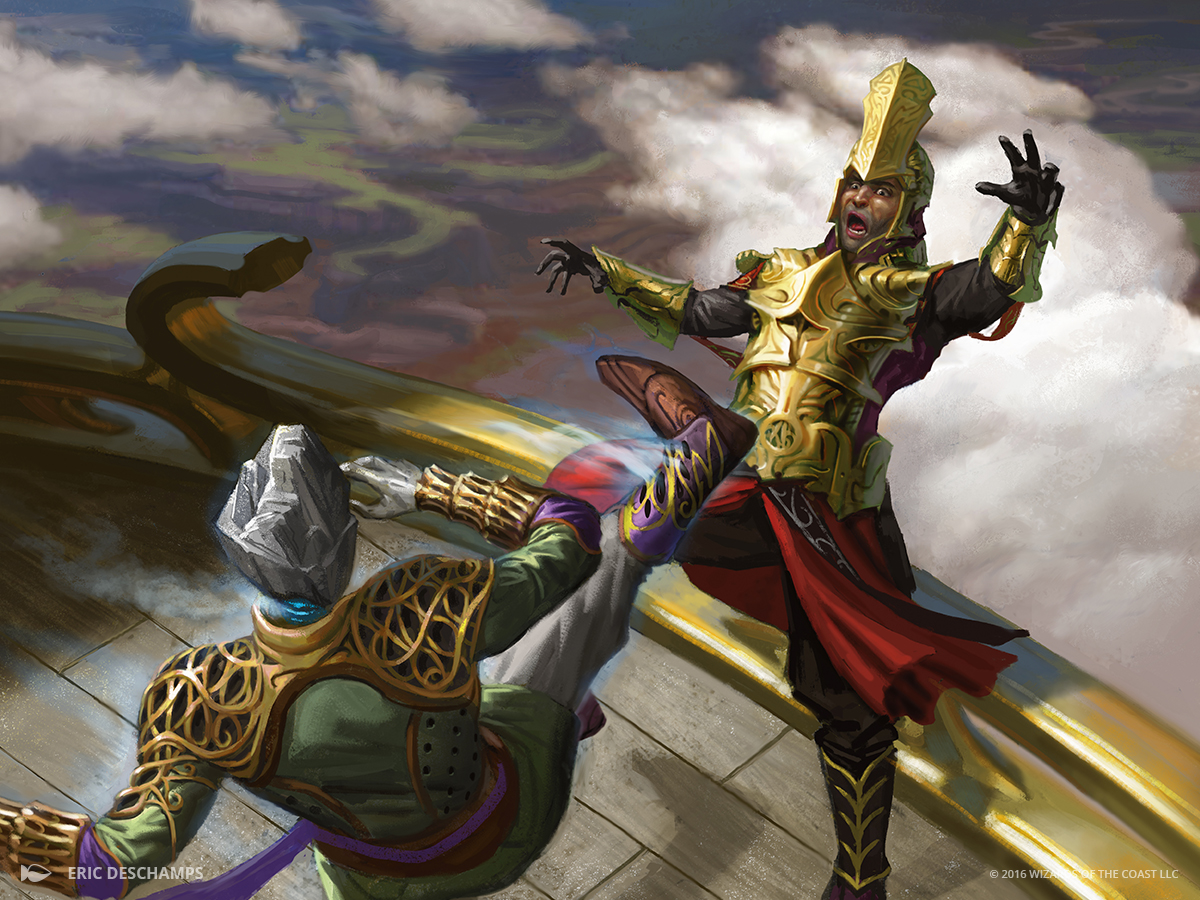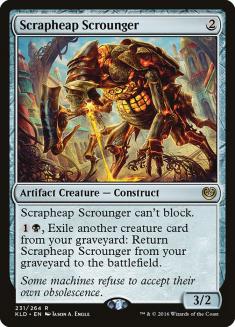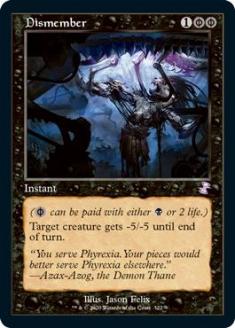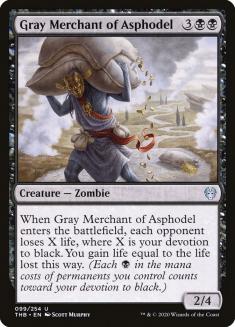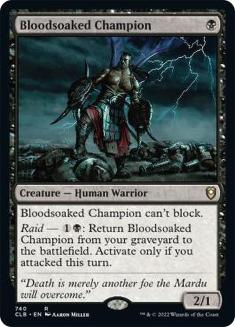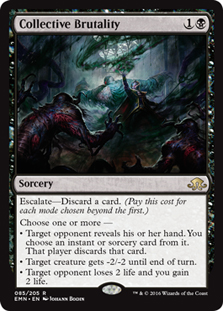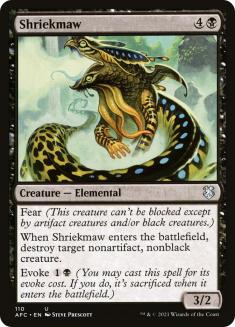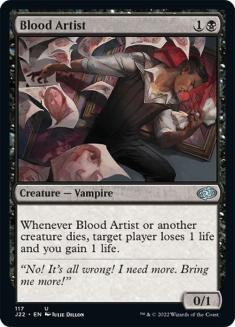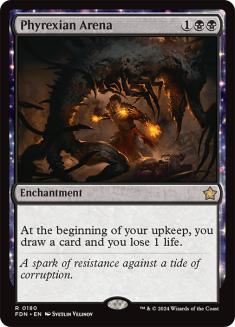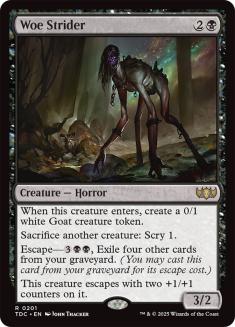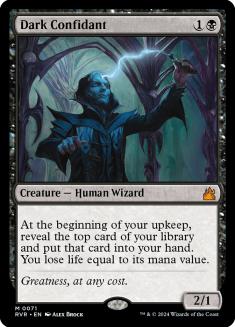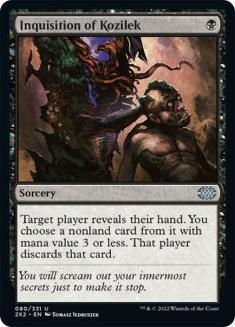Howdy, gamers, and welcome to another installment in my series on the most Cubeable cards in Magic. I’ve already tackled white and blue, which means this week we’re doing black.
Black is arguably the most difficult color to work with in the world of Cube curation, and is regularly my pick for the weakest color in the assorted digital Cubes. It’s not that black doesn’t get its share of individually powerful cards, but more that black’s themes are often some combination of parasitic and shallowly supported.
Case in point, black aggressive decks have suffered for years from Carnophage being uncomfortably high on the list of best options for one-drops. I felt the tides turning when Knight of the Ebon Legion was printed, but unfortunately the one-drop well has run dry again since then. A lot of Cubes end up leaning on a sacrifice or reanimation theme to make the color work, and you’ll see from my list that I’m much bigger on the play patterns of one than the other.
Honorable Mentions
Before I get to my official list, I do have two honorable mentions for black. Similar to Porcelain Legionnaire in white, these are two cards that benefit from access to black mana, but that I’m willing to put in the colorless section in a Cube because they don’t necessitate access to much or any black mana:
Dismember was just a game-changing card in Magic, and while I’m more likely to use it as an answer to high-toughness creatures in my red decks or meaningful interaction in my green decks, it’s still high on my list of cards that I like to include in Cubes. Similarly, I’ll “splash” Scrapheap Scrounger with a single black source or even go without entirely if I need a two-drop in my aggressive decks.
It doesn’t feel right to give black slots to these mostly colorless cards, but it also doesn’t feel right to exclude these cards from a lot of Cubes. With that out of the way, let’s get to the list!
10. Gray Merchant of Asphodel
I’ve made my anti-pip stance abundantly clear since I’ve started creating content in the Cube sphere, but it’s hard to argue with the popularity of Gray Merchant of Asphodel and the joy that the card can bring. A staple of Pauper and Peasant Cubes alike, Gray Merchant isn’t cut out for Vintage Cube, but there are a lot of power levels in-between where the card is right at home.
It’s not usually of much consequence that the card is a Zombie, but being a powerful card to blink can come up in a big way. I’m actually more interested in Cubes where Gray Merchant of Asphodel can make meaningful appearances in two-color decks than in ones with incredibly prohibitive casting costs like that of Phyrexian Obliterator. Oubliette and just generally good permanents that have black pips instead of stuff that forces you to play mono-Swamps go a much longer way in creating a dynamic draft and play environment.
Gray Merchant of Asphodel is remembered as a very powerful card for appearing at common in its debut Draft environment and for being a part of a very powerful Standard deck, and this history makes the card an exciting first pick. It’s much more tame in the world of singleton Cubes, and cards that are playable and exciting without being overly powerful lead to great play experiences.
9. Bloodsoaked Champion
I’m probably a bigger fan of Knight of the Ebon Legion, but Bloodsoaked Champion gets the nod as the more broadly Cubeable card due to its significance as a recurrable one-drop in sacrifice decks. Human and Warrior are both tribes with a good amount of support to boot.
If you want to make an aggressive archetype work, then it’s important to allow that archetype to get on the battlefield early and often. Whether you’re trying to support Bloodsoaked Champion’s tribes, generic black aggressive decks, or sacrifice decks, it’s a no-brainer for inclusion in a lot of Cubes.
8. Collective Brutality
Collective Brutality is one of those modal spells that plays much better than it looks. Whether you’re looking for a discard outlet and a way to clear the path for your Reanimator deck in a high-powered Cube, or a discard outlet for a madness deck in something like my Spooky Cube, Collective Brutality is a great tool for the job.
Barring that, it’s just a nice removal spell to keep red aggressive decks from running the table over that comes at a rate that doesn’t feel oppressive. Collective Brutality offers reach to aggressive decks, interaction to control and combo decks, and an enabler for graveyard strategies. There’s just a ton to like here.
7. Shriekmaw
Ravenous Chupacabra is the de facto Nekrataal these days, but Shriekmaw is special. The evoke ability can matter in all kinds of interesting ways. Maybe you want to trigger revolt, maybe you gain some benefit from sacrificing the body right away with something like Priest of the Forgotten Gods, or maybe you really want to mess up your opponent’s battlefield with an Ephemerate. Creatures that can put themselves in the graveyard for low amounts of mana are also nice to have around for decks that care about threshold and delirium. Shriekmaw is on its face a solid value card, but there’s a lot more going on here.
Maybe my list should feature some Doom Blade-style cards, and the actual Doom Blades do show up in most Cubes, but Shriekmaw opens up a lot more possibilities in terms of what you can do with the card. A Peasant Cube staple, a card that is literally in the Magic Online (MTGO) Vintage Cube, and a card that meaningfully contributes to a range of archetypes for all kinds of Cubes in between, Shriekmaw has long been a favorite of mine.
6. Blood Artist
Blood Artist is one of the quintessential cards for supporting sacrifice decks. One of the satisfying aspects of drafting these archetypes is that they can win games by making “chump attacks” and getting value when their creatures die, as opposed to more traditional aggressive decks which can struggle when the opponent starts outsizing you on the battlefield. Blood Artist has been stealing games for sacrifice decks for ten years now, and remains a staple after all that time.
I’ve messed around with Vampires as a supported tribe, but they’re a bit too parasitic for my taste. This isn’t to say that nobody should Cube with them, though, and Vampires do naturally offer some overlap with sacrifice themes with cards like Kalastria Highborn and Bloodthrone Vampire.
Blood Artist is mostly just a great rate for a powerful effect for sacrifice decks, and this is more than enough for the card to show up in any Cube sporting a sacrifice theme.
5. Phyrexian Arena
Anybody who thinks they’re too good for a one-sided Howling Mine is kidding themselves, and Phyrexian Arena offers just that. For a price. I actually really enjoy the tension that comes with losing a life every turn, and card advantage with life loss tacked on helps to keep aggressive decks competitive even against the mountain of card advantage that Phyrexian Arena offers.
Black’s planeswalker spread is pretty modest, which helps keep Phyrexian Arena in the conversation for most Cubeable black cards. You’ll want to do some combination of trying to close the game quickly and gaining life if you control this powerful enchantment, but black is quite good at both of these things. Specifically, Phyrexian Arena is one of my favorite cards to pair with Gray Merchant of Asphodel in non-rarity-restricted Cubes.
We tend to see more cards with paragraphs of positive text these days than good cards with drawbacks, and part of me does pine for the days of cards where you had to more actively weigh the downside against the upside. The tension that Phyrexian Arena generates in Cubes with reasonable aggressive decks leads to some of my favorite games of Magic.
4. Woe Strider
Speaking of cards with paragraphs of positive text, I think Woe Strider flies a little under the radar for how powerful the card is. While eclipsed by the more powerful escape cards in Uro, Titan of Nature’s Wrath and Kroxa, Titan of Death’s Hunger, Woe Strider is a high pick for me for sacrifice decks. The free Goat to sacrifice and the ability to come back bigger later both make the card well worth the price of admission. I’ll also say that Woe Strider not being able to sacrifice itself helps to balance the card by making it vulnerable to removal spells that exile, and I’m a big fan of leaving this avenue for counterplay open.
Woe Strider also just comes with enough stats to be playable in a deck that isn’t all that interested in sacrifice payoffs. It’s a formidable blocker for control decks, for example. It falls in the category of being quietly powerful, capable of swinging games without being groan-inducing. Again, this is the sweet spot.
3. Dark Confidant
If I’m big on Phyrexian Arena, then you’d better believe I’m big on Dark Confidant. One of my picks for the most underrated cards in the MTGO Vintage Cube, Dark Confidant in similar to Jace, Vryn’s Prodigy in that the card threatens to win the game for its controller while being vulnerable to a slight breeze. The loss of life also means that Dark Confidant generates the tension that I love so much.
Being a Human is relevant for some Cubes, and being a cheap body that you’ll have some interested in sacrificing some of the time also increases Dark Confidant’s stock as a Cube card. Beyond that, Dark Confidant ends up being incredibly good in high-powered environments where you see more combos and decks generating card advantage efficiently than you do aggressive decks.
Dark Confidant just rules, though if you’re interested in slower games and Cubes with higher mana curves, it will be a poor fit. So I wouldn’t advocate to see this one in the Live the Dream Cube, but there are plenty of other Cubes where it’s right at home.
2. Thoughtseize (and Inquisition of Kozilek)
Something that I see in a lot of Cubes is players including discard spells that are specific to their environment and eschewing the more generic Thoughtseize. There’s a difference of philosophy at play here, and if you’re really into Ostracize or whatever discard spell you like, then by all means do your thing, but I’m going to state my case for why Thoughtseize is totally fine for more Cubes than it’s considered for.
Discard by its nature has deeply diminishing returns. As the game progresses, you’ll have less and less opportunity to meaningfully leverage a discard spell. Cards in hand diminish. Pressure on the battlefield increases. It’s easy to understand why discard spells are weak topdecks in a lot of games.
Mini-Rant: Missing with Discard
Beyond that, though, I consider a discard spell missing in the early-game to be one of the worst case scenarios for a player. It is miserable to sign up for what you believe the play experience to be and have the rug pulled out from under you. What’s worse, being Thoughtseized with an average hand, or casting Appetite for Brains on Turn 1 and missing?
Again, this is a matter of personal philosophy and your answer might be different from mine, but for me, it’s whiffing with a discard spell, and it’s just not close to being close. Couple that with the natural diminishing returns of discard spells by volume as the game goes long, and you can understand why I bias towards the more generic and powerful options.
Back to Thoughtseize
If your Cube lends itself to decks that generally fold to one targeted discard spell, then it makes more sense to not include any option rather than to specifically feature less consistent ones. And if your Cube has a relatively tight power band and decks that can weather being hit by a discard spell or two, it’s just more fun to play with the good ones. Thoughtseize is totally fine in midrange mirrors and completely necessary to combat broken decks.
I don’t love Thoughtseize for more synergy-driven environments, but that’s mostly because it doesn’t synergize with much. It does work with spells-matters themes, though, and I’m a huge proponent of featuring the card in any Cube that has any emphasis on individually powerful cards.
1. Fatal Push
So there aren’t any two-mana Doom Blades on my list, but Fatal Push is just one of those no-brainer Cube inclusions for me. A common theme in my lists so far is that I like keeping one-for-one interaction at a high power level, and Fatal Push is a crucial card for keeping black interaction lean and efficient.
I like one-mana creatures, and to stop them from being dominant, it’s important to have one-mana removal. Fatal Push is great at what it does, and it’s also charming that you have to work a little to kill three- and four-mana creatures.
Creatures and combat are essential parts of the best Cube experiences for my money, and keeping creatures in check should be one of black’s strengths. In addition to Fatal Push, I do like finding some number of appropriate Doom Blade variants, usually Go for the Throat, to give players something to think about as they deploy their threats.
Black is one of the colors that I watch most closely for significant shifts in what is possible for Cube during preview season, and while I really like where sacrifice decks are these days, black still has a lot of room to grow. That said, black does offer some good removal, some aspirational cards, and some modest card advantage, and it’s a lot better off than where it used to be.
Join me next week as I continue this series and break down my picks for the ten most Cubeable red cards!

